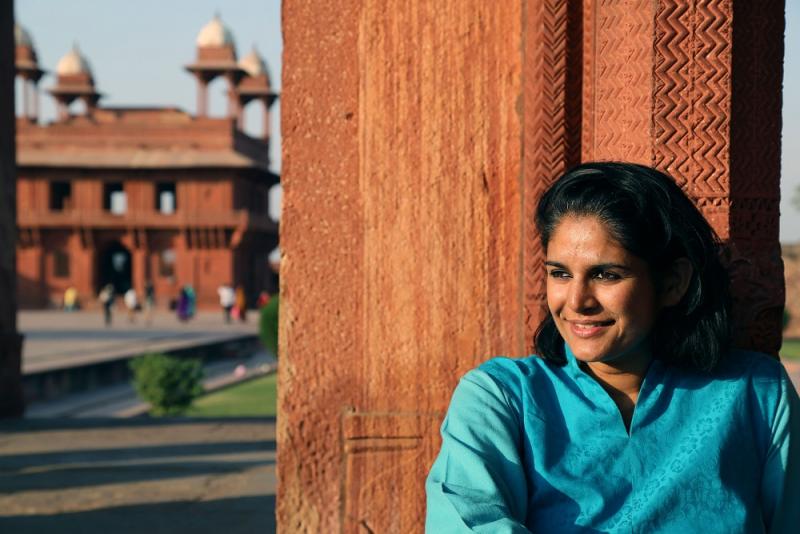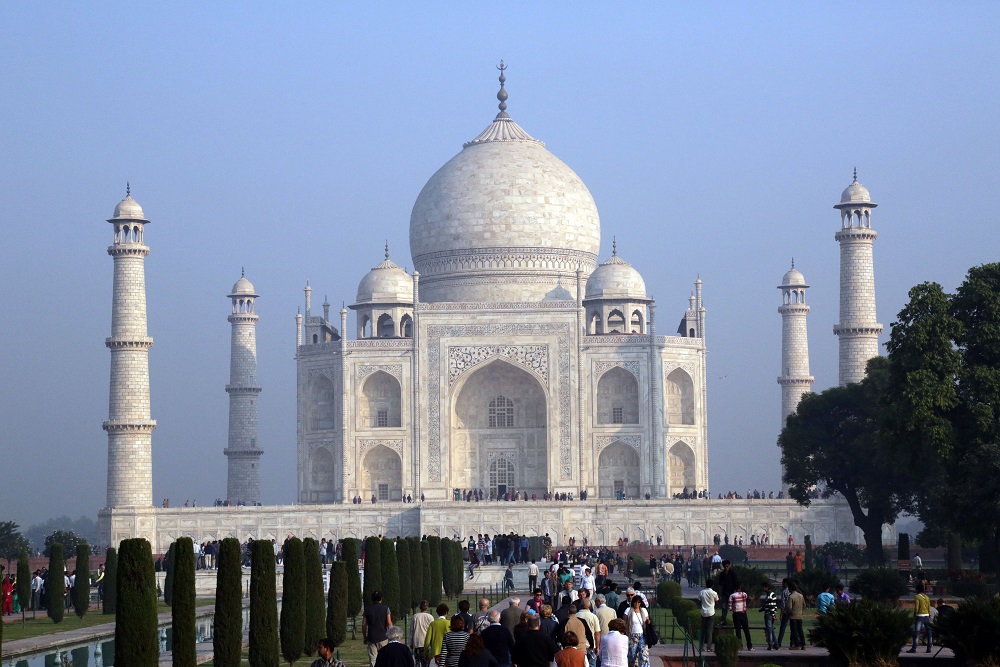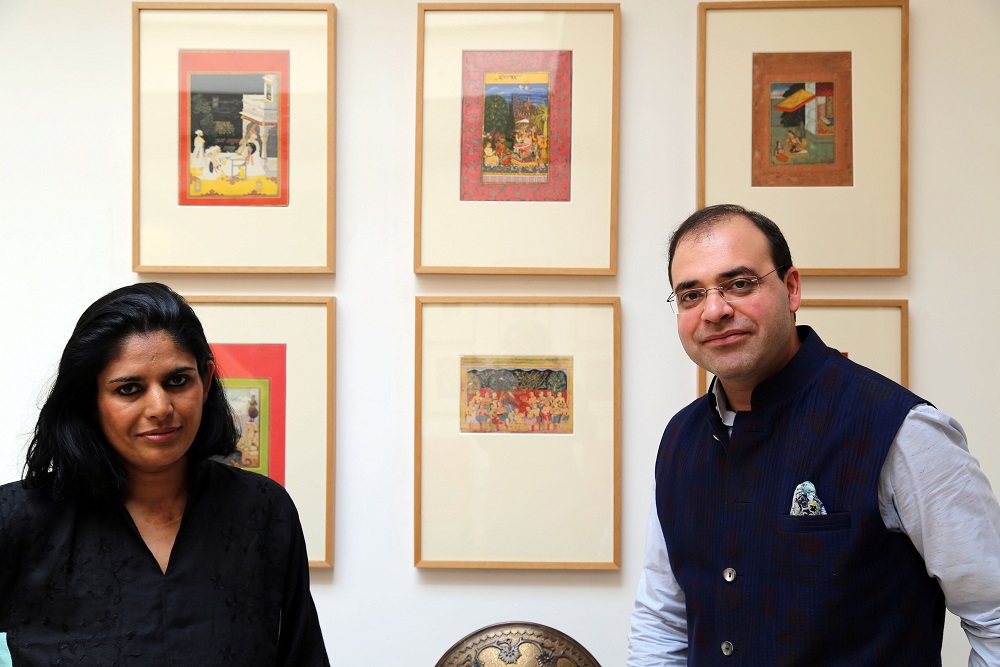Treasures of the Indus, BBC Four | reviews, news & interviews
Treasures of the Indus, BBC Four
Treasures of the Indus, BBC Four
An outstanding guide takes us through the culture, and wider history, of the Indian subcontinent

The BBC India Season is bringing us a cluster of programmes amounting to a fascinatingly varied series of visits to the subcontinent. Incidentally, and not coincidentally, there is also an India Festival with myriad exhibitions, conferences and lectures at the Victoria and Albert this autumn.
Sona Datta began her career at the British Museum and is now the lead curator at the Peabody Essex Museum in Salem, Massachusetts, the most important museum in the USA that Europeans have never heard of, which has significant holdings in Indian art. British by birth, Bengali by heritage, she is enthusiastic, immensely knowledgeable and combines the outlooks of both insider and outsider. Her trilogy of programmes, of which this – The Other Side of the Taj Mahal – was the second, is much more than just a highly intelligent and visually beguiling tour of the great buildings and arts of India. It is a subtle and even provocative visual history of some 5,000 years of waves of migration, of empires built and lost, of different cultures and religions living together at times in amity, at times in open warfare.
Akbar determined to tolerate and even welcome all manifestations of religion in his empireHer first episode, Pakistan Unveiled, set the scene with a revelatory look at the remnants found by archaeologists of the sophisticated cities of the Indus Valley civilisations in Northern Pakistan from some 5,000 years ago: Harappa was not only a city of some 80,000 set out on a grid pattern, but there is evidence in sculptural fragments that the Indus Valley cultures worshipped powerful women. Millennia later one of the most famous conquerors of history, Alexander the Great, paid a visit (in 330 BC) altering the culture by leaving a legacy of Indo-Hellenistic art. The ruins of Buddhist monasteries and sculptures (now rescued to be shown in museums) demonstrate the wealth of the succeeding rich trading Indo-Greek cultures of northwest Pakistan, known as Gandhara, and the visual fusion that created some of the most beautiful stone sculptures in art.
This follow-on dealt with the period most familiar to westerners, that of the great Mughal emperors. The famous and infamous ancestors of Babur (1483-1530) included Tamerlane and Genghis Khan, and Babur was not averse himself to conquering new lands, sweeping into the north of India (Henry VIII was ruling England at the time). Centuries on, his great-great-great-grandson, the fratricidal military genius and master of intolerance, Aurangzeb (1618-1707) had neither understanding of nor care for the culture and liberalism that had made his dynasty great.
We started in Lahore: Babur, the Muslim from Central Asia, was forthright in his condemnation of what he found there – ugly people, who could not provide good food, dogs or horses, although he was naturally attracted to the region’s large natural resources of gold and silver. He proceeded in an astonishingly short time to turn Lahore into a garden city with marvellous monuments and water features, some of which remain today: the garden, then as now, an earthly paradise. As a young Pakistani musician and scholar remarked in the first episode, the region is politically very young and culturally very old, its first cities going back five millennia. From Lahore, the Mughals pushed onwards into the vast subcontinent which derived its name from the river Indus.
 It was a turbulent world: Babur himself battled ferociously with alcohol, at one point destroying many of his literally priceless drinking vessels, themselves a high point of Mughal art, and distributing their valuable remnants to the poor. The reign of Babur’s grandson and successor, Akbar, was perhaps the most sympathetic and mysterious of all. Six hundred kilometres to the south of Lahore, Akbar built the Red Fort in Agra, another great monument, and nearby the redstone city of Fatehpur Sikri which was eventually mysteriously abandoned, but remains an architectural wonder. He and his court were ardent huntsmen, herding together huge varieties of wild animals for the pleasure of killing them. A thousand cheetahs were trained to hunt, as westerners might train dogs.
It was a turbulent world: Babur himself battled ferociously with alcohol, at one point destroying many of his literally priceless drinking vessels, themselves a high point of Mughal art, and distributing their valuable remnants to the poor. The reign of Babur’s grandson and successor, Akbar, was perhaps the most sympathetic and mysterious of all. Six hundred kilometres to the south of Lahore, Akbar built the Red Fort in Agra, another great monument, and nearby the redstone city of Fatehpur Sikri which was eventually mysteriously abandoned, but remains an architectural wonder. He and his court were ardent huntsmen, herding together huge varieties of wild animals for the pleasure of killing them. A thousand cheetahs were trained to hunt, as westerners might train dogs.
Such scenes were celebrated and memorialised in vivid colourful miniatures, no detail too small to be carefully delineated. But one day Akbar had a fit – either a seizure or an epiphany: the result was that all the wild animals brought together for a hunt were released back into their natural habitats. Akbar determined to tolerate and even welcome all manifestations of religion in his empire: Buddhism, Hinduism, Jainism, and the mystical, celebratory all-singing, all-dancing branch of Islam, Sufism. There were, said the enlightened Emperor, many pathways to god.
Akbar’s grandson Shah Jahan – his name meant “the glory of the world” – was best known for creating the grandest monument to love set in stone, the Taj Mahal, in memory of his favourite wife, Mumtaz Mahal. She died at the age of 38 giving birth to his 14th child; the Emperor mourned for two years, and called in the skills of Indian craftsmen, Baluchistan stone-cutters, Persian calligraphers and architects from the Ottoman Empire to create the marble mausoleum, a fantasy of what might be the royal dwelling in paradise. The Taj Mahal (pictured above) was described by a poet as a teardrop on the cheek of time, and our empathetic narrator confided that she had first seen it when she was only eight, and every time she visited, the thrill never lessened.
 The courts of the Emperors demonstrated, in Datta’s phrase, the changes of methods and cultures, from the roving entourages of Babur, the outward-looking symposia and endless discussions of the enlightened Akbar, and the massive buildings of marble of Shah Jahan. And then disaster struck in the form of the unloved and rejected son, Aurangzeb, who not only imprisoned his father but toppled his principled but weak older sibling, Dara Shikoh, from the throne and had him murdered in the most gruesome way imaginable. He was also ferociously intolerant.
The courts of the Emperors demonstrated, in Datta’s phrase, the changes of methods and cultures, from the roving entourages of Babur, the outward-looking symposia and endless discussions of the enlightened Akbar, and the massive buildings of marble of Shah Jahan. And then disaster struck in the form of the unloved and rejected son, Aurangzeb, who not only imprisoned his father but toppled his principled but weak older sibling, Dara Shikoh, from the throne and had him murdered in the most gruesome way imaginable. He was also ferociously intolerant.
To act at times as profoundly unwilling hosts to invaders and empire-builders has been the subcontinent’s fate, and the programme ended with archive of the 20th century British Raj, unsympathetic to and uninterested in the indigenous cultures, which followed an ultimately disastrous policy of divide-and-rule, setting adherents of Islam and Hinduism against each other, and not smoothing over the animosities of rival principalities. There were brief but harrowing glimpses, dramatic in black and white in contrast to the sumptuous colour of the programme’s photography, of the riots and deaths of the times of independence and partition in 1947.
Datta also queried the ultimate value of the three centuries of the Mughal Empire, as it moved from tolerance to repression. Her view was that India still struggled with religious and cultural identity, and that in the shared history of the whole subcontinent one could not understand one country, Pakistan, without the other, India.
In the hands of this highly intelligent and involved guide, we were treated to more than just the sight of glorious buildings and gorgeous paintings; more than art history, this was history in every sense (her interviewees included many cultural practitioners and commentators: Datta with collector and critic Nitin Bhayana, pictured above). Even the music by Nainita Desai and Malcolm Laws added to the emotive atmosphere, the photography by Spike Geilinger, from markets and alleyways to gardens and tombs, always apposite, and the whole excellently woven together under the oversight of Hugh Thomson. We have Datta’s final instalment, Of Gods and Men, to look forward to next week.
Add comment
The future of Arts Journalism
You can stop theartsdesk.com closing!
We urgently need financing to survive. Our fundraising drive has thus far raised £49,000 but we need to reach £100,000 or we will be forced to close. Please contribute here: https://gofund.me/c3f6033d
And if you can forward this information to anyone who might assist, we’d be grateful.

Subscribe to theartsdesk.com
Thank you for continuing to read our work on theartsdesk.com. For unlimited access to every article in its entirety, including our archive of more than 15,000 pieces, we're asking for £5 per month or £40 per year. We feel it's a very good deal, and hope you do too.
To take a subscription now simply click here.
And if you're looking for that extra gift for a friend or family member, why not treat them to a theartsdesk.com gift subscription?
more TV
 Murder Before Evensong, Acorn TV review - death comes to the picturesque village of Champton
The Rev Richard Coles's sleuthing cleric hits the screen
Murder Before Evensong, Acorn TV review - death comes to the picturesque village of Champton
The Rev Richard Coles's sleuthing cleric hits the screen
 Black Rabbit, Netflix review - grime and punishment in New York City
Jude Law and Jason Bateman tread the thin line between love and hate
Black Rabbit, Netflix review - grime and punishment in New York City
Jude Law and Jason Bateman tread the thin line between love and hate
 The Hack, ITV review - plodding anatomy of twin UK scandals
Jack Thorne's skill can't disguise the bagginess of his double-headed material
The Hack, ITV review - plodding anatomy of twin UK scandals
Jack Thorne's skill can't disguise the bagginess of his double-headed material
 Slow Horses, Series 5, Apple TV+ review - terror, trauma and impeccable comic timing
Jackson Lamb's band of MI5 misfits continues to fascinate and amuse
Slow Horses, Series 5, Apple TV+ review - terror, trauma and impeccable comic timing
Jackson Lamb's band of MI5 misfits continues to fascinate and amuse
 Coldwater, ITV1 review - horror and black comedy in the Highlands
Superb cast lights up David Ireland's cunning thriller
Coldwater, ITV1 review - horror and black comedy in the Highlands
Superb cast lights up David Ireland's cunning thriller
 Blu-ray: The Sweeney - Series One
Influential and entertaining 1970s police drama, handsomely restored
Blu-ray: The Sweeney - Series One
Influential and entertaining 1970s police drama, handsomely restored
 I Fought the Law, ITVX review - how an 800-year-old law was challenged and changed
Sheridan Smith's raw performance dominates ITV's new docudrama about injustice
I Fought the Law, ITVX review - how an 800-year-old law was challenged and changed
Sheridan Smith's raw performance dominates ITV's new docudrama about injustice
 The Paper, Sky Max review - a spinoff of the US Office worth waiting 20 years for
Perfectly judged recycling of the original's key elements, with a star turn at its heart
The Paper, Sky Max review - a spinoff of the US Office worth waiting 20 years for
Perfectly judged recycling of the original's key elements, with a star turn at its heart
 The Guest, BBC One review - be careful what you wish for
A terrific Eve Myles stars in addictive Welsh mystery
The Guest, BBC One review - be careful what you wish for
A terrific Eve Myles stars in addictive Welsh mystery
 theartsdesk Q&A: Suranne Jones on 'Hostage', power pants and politics
The star and producer talks about taking on the role of Prime Minister, wearing high heels and living in the public eye
theartsdesk Q&A: Suranne Jones on 'Hostage', power pants and politics
The star and producer talks about taking on the role of Prime Minister, wearing high heels and living in the public eye
 King & Conqueror, BBC One review - not many kicks in 1066
Turgid medieval drama leaves viewers in the dark
King & Conqueror, BBC One review - not many kicks in 1066
Turgid medieval drama leaves viewers in the dark
 Hostage, Netflix review - entente not-too-cordiale
Suranne Jones and Julie Delpy cross swords in confused political drama
Hostage, Netflix review - entente not-too-cordiale
Suranne Jones and Julie Delpy cross swords in confused political drama

Comments
Sonal Data, this highly
i think that she does have a
Dr. Sonal Datta created the
I found this series very
Dr. Sonal Datta created the
I believe it is an
Dear Sir/Madam, I don't
Sorry but your assertion of
Sorry but your assertion of bias is quite wrong. My wife and I have travelled through the subcontinent a number of times, and felt Sona Datta gave a very balanced view. Maybe your point of view is biased due to the antipathy between both countries up to the present day.
I swear i have never been so
I swear i have never been so bored in all my life.i love history.but my god that womens voice is so boring i cant take anything in.what the hell is she going on about?
Thank you, Dr. Datta for a
A rather annoying series, as
A rather annoying series, as you spend half your time counting the factual errors, and the other half slapping your head at Sona Datta gullibility. As not even a first year: archaeology, history, journalism, ... undergraduate, when presented with the supposed ring of King Porus would broadcast it as a fact, before demanding a verifiable provenance; especially when the claim is made by a bloke she's never met before. Also where did the population of 80,000 come from for Harappa, as every published estimate has been in the 20,000 to 50,000 range, and I can only guess what she was thinking when claiming no european City had been planned or exceeded Harappa's population before the 19th century. Even if she has access to some unpublished evidence for a population of 80,000, this is still less than the 100,000 Knossos is estimated to have achieved in the 18th Century BCE, and that of both Athens and Rome in the 7th century BCE, or Constantinople in the 6th Century CE, and those Romans liked their grids and urban planning. Though it's no worse than claiming Fatehpur Sikri was built from nothing to be a larger and grander than Constantinople, Baghdad, Beijing, Nanjing, Cairo, Rome, Naples, Venice, ... and abandoned all in the space of 1569-1585.
There series also failed to mention the Sikh empire, or the Marathas, Portuguese, or French, as all have left a mark on south Asia, and those Portuguese with their collegiate education, paper, printing, perspective drawing, ... have had a significant cultural impact.